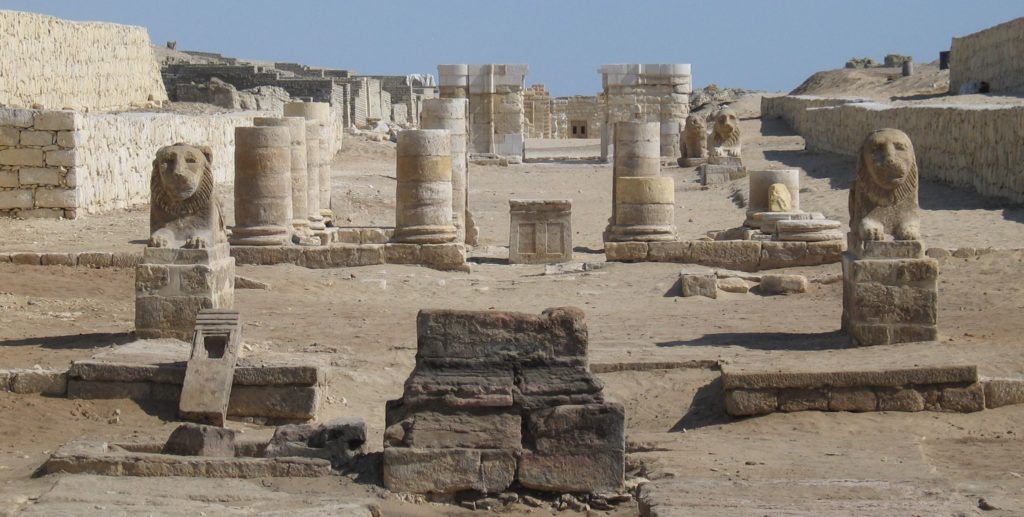
Il tempio di Medinet Madi fu portato alla luce tra il 1935 e il 1939, cioè fino allo scoppio della seconda guerra mondiale, da Achille Vogliano. Lo studioso milanese scoprì l’unico tempio di culto del Medio Regno conosciuto finora in Egitto, completo di testi e di sculture, incapsulato e conservato negli ampliamenti fatti durante il periodo tolemaico e romano a sud e a nord della struttura originaria. Il piccolo tempio fu fondato insieme con la città di Gia dal faraone Amenemete III nel II millennio a.C., nel quadro delle misure prese dai sovrani del Medio Regno per accrescere le risorse agricole nel Fayum. Il tempio era dedicato a Renenut, la dea Cobra, signora delle messi e dei granai e protettrice del faraone, che fu poi assimilata in epoca tarda con la dea Isi sotto il nome di Isi-Thermuti. Il nome della dea dette origine al toponimo Narmouthis “La città di Renenut” in uso durante l’epoca greco-romana. Nel culto Sobek, il dio coccodrillo signore del Fayum, era associato al Cobra Renenut, la “Renenut vivente di Gia”, come la chiamano i testi geroglifici di Medinet Madi. Amenemete III e il suo successore Amenemete IV sono rappresentati in bei rilievi sui muri del tempio che comprende una ipostila con due colonne e una sala trasversale con tre celle.
Durante l’epoca tolemaica, probabilmente sotto Tolomeo Soter II, furono aggiunti tre cortili, un vestibolo e un altro tempio appoggiato sul lato nord; l’insieme è circondato da uno spesso ed alto muro di mattoni crudi con un grande portale a sud e uno a nord. Sugli stipiti dell’ingresso della prima corte, Achille Vogliano trovò incisi i quattro inni in greco composti da Isidoro, un egiziano grecizzato, in onore di Isi Thermuti e del fondatore del tempio, Amenemete III. Un lungo dromos, o viale, fiancheggiato da sfingi, conduceva, oltrepassato l’enorme portale sud del temenos, a un chiosco. L’area oltre il portale nord, secondario, è stata modificata in epoca romana con l’aggiunta di una grande corte porticata o stoà (m 50 x m 30) di grande interesse archeologico. L’area del tempio coi suoi annessi è senza dubbio la parte più significativa. Ma molto resta da esplorare a Medinet Madi, che fornisce resti archeologici che vanno dal II millennio a.C. al tardo periodo cristiano. Nel settore copto, esplorato sistematicamente negli ultimi anni, sono state scoperte e rilevate ben dieci nuove chiese paleocristiane, a pianta basilicale, alcune di imponenti dimensioni, ricche di sculture; sono state trovate pagine di un codice in copto (VI secolo), ceramica, sculture in legno.
Le ricerche della campagna 1995 si sono concentrate sul pianoro soprelevato, a est del temenos del tempio tolemaico di Renenut e di Sobek; dalla piccola porta secondaria del tempio, aperta a nello spessore del grosso muro di cinta, si scende al livello della piazza o strada mediante una scaletta di cinque gradini di pietra, e a 6 metri di distanza dal temenos, quasi nell’asse della scala, gli scavi hanno portato alla luce un portale monumentale in blocchi di calcare (cm.80x50x25) conservato per cinque assise, che veniva chiuso con un battente ( la base di bronzo del cardine era in situ), di stile e modulazione tolemaica, l’impressionante kom di scarico antico nel quale è stata rilevata la stratigrafia. Nel programma dei lavori di liberazione (1995-1996) dell’area templare dalla sabbia che durante sessant’anni, cioè dal tempo delle scoperte di Achille Vogliano, tra il 1935 e il 1939, si è accumulata arrivando a ricoprire buona parte dei cortili, del dromos, degli annessi del tempio del Medio Regno e del tempio tolemaico nord, è stato riportato alla luce, nel corridoio est, tra il tempio faraonico e il muro del temenos, il sacello dedicato a Isi-Thermuti, nella sua forma muliebre e anguiforme, “per la salute di Augusto”, che il Vogliano ritrovò nel 1938; la bella stele con la figura a rilievo della dea è stata ritrovata, caduta e spezzata in due parti, ma sostanzialmente in buon stato, ed è stata portata nel magazzino della missione di Medinet Madi.
Le operazioni di sgombro hanno permesso di rimettere in vista la stoà – una grande corte, circa m.50 x 30, con porticati a colonne con capitelli corinzi, collegata col portale del tempio nord mediante una imponente entrata monumentale; il Vogliano aveva già portato avanti il nettoyage di buona parte della zona prima di dover chiudere il cantiere per l’inizio della guerra, nel 1939. La missione pisana ha documentato i cambiamenti apportati in epoca romana (prob. II sec. d.C.) alle strutture del massiccio est del portale nord del temenos al momento in cui fu aggiunta, verso nord, la stoà; il muro di cinta dei porticati è stato costruito in grande parte utilizzando blocchi di pietra con mattoni crudi. Una singolare scalinata a doppio pendio, convergente in alto su un pianerottolo, posta all’angolo Sud-est del portico, permetteva probabilmente di raggiungere una porta secondaria, aperta nello spessore del muro di cinta, sul tipo di quella sul lato meridionale del temenos del tempio. L’équipe formata dagli architetti A.Giammarusti e C.La Torre, con il topografo e fotogrammetra R.Cozzolino (SO.BE.CA. di Roma), ha portato avanti il rilievo dei monumenti templari di Medinet Madi; l’egittologa pisana Flora Silvano e la disegnatrice Lucia Grassi hanno completato la documentazione grafica dei testi e delle scene scolpite del tempio di Amenemete III (Tempio A) e del tempio tolemaico nord (Tempio B); rilevazioni tecniche e disegni fanno parte del progetto di restituzione tridimensionale dei templi di Medinet Madi e di maquettes virtuali, e vede la collaborazione con l’Università di Pisa del Museo Archeologico milanese, diretto dal Prof. Ermanno Arslan. Fra i ritrovamenti del 1996 il pezzo più interessante è la statua virile, acefala, in marmo (alt. m. 0,80 circa) d’epoca romana; l’uomo porta un chiton e un himation drappeggiato; due dita della mano sinistra, appoggiata sul petto, sono ornati di anelli con castone . Nella campagna 1997, è continuata l’esplorazione del nuovo edificio templare (Tempio C) d’epoca tolemaica costruito, in alto sul pianoro e orientato est-ovest, in mattoni crudi cui dà accesso la grande porta scoperta nel 1995; dopo un cortile, presso il secondo portale in blocchi di arenaria polita sormontata dall’architrave con gorgia , giacevano tre pezzi di scultura in cattive condizioni ma non per questo meno interessanti come elementi di un’architettura templare: due leoni del tipo accovacciato, le zampe anteriori incrociate (lungh. Max. m.0,66), e una sfinge, cioè un leone con testa di faraone, di tipo tolemaico. La costruzione è benissimo conservata, sul perimetro, per un’altezza di m.4/4,20; è lunga m. 16,30, in mattoni crudi di modulo tolemaico (cm.30 x 15 x 12), larga in facciata circa 12 metri; i due muri che fiancheggiano la porta hanno uno spessore di m.1,75, mentre i muri laterali sono spessi m. 0,90.
Hanno fatto parte delle varie missioni, tra il 1995 e il 1997: E.Bresciani, l’arch. P. Grossman, l’arch. A.Giammarusti (direttore tecnico), l’arch. R.Cozzolino, R.Pintaudi (Università di Messina), F.Silvano, L.Grassi. Accompagnava le Missioni l’Ispettore delle antichità del Fayum Sayed Moh. Helal.
L’impegno e i risultati più importanti si sono avuti dalle campagne di scavo effettuate, a marzo e a novembre 1998, a Medinet Madi nel Fayum, attività che ha visto anche interventi di protezione delle strutture litiche a Medinet Madi e a Khelua. La campagna 1995 aveva portato alla luce soltanto la parte iniziale di un grande edificio orientato est-ovest cui si accedeva mediante un portale monumentale di blocchi di calcare di stile e modulazione tolemaica. L’edificio templare preannunciato dal grande portale è stato effettivamente ritrovato; si tratta di una costruzione in mattoni crudi di modulo tolemaico (cm.30 x 15 x 12), lunga m. 16, 50 e larga circa 12 metri. L’edificio è benissimo conservato, sul perimetro, per un’altezza di m.4/4,20. Davanti alla porta, nella parte finale del corridoio della struttura 1995, giacevano tre pezzi di scultura in cattive condizioni ma non per questo meno interessanti come elementi di un’architettura templare che appare tipica del Fayum: due leoni del tipo accovacciato, le zampe anteriori incrociate, e una sfinge, cioè un leone con testa di faraone.
La missione dell’Università di Pisa in congiunzione con l’Università di Messina, ha portato completamente alla luce, nella campagna novembre 1998, l’edificio sacro che gli indizi facevano sperare; è risultato trattarsi di un tempio per il culto di due coccodrilli, forse Sokonopis e Soknopaio oppure Soknebtunis. Il santuario, di mattoni crudi ed elementi architettonici in calcare, è completo nei suoi elementi: grande portale d’accesso (1995) inserito nel muro del temenos, propilone in pietra (marzo 1998), con cornice a gorgia, che permette l’accesso al vestibolo (nicchie sulle pareti, due porte (alt. m. 1,45) alle estremità nord e sud; la porticina sud dà accesso alla scala costruita attorno a un massiccio centrale, che saliva fino alla terrazza del tempio, a un’altezza di oltre 4 metri; scala eccezionalmente ben conservata, con gradini in mattoni crudi rinforzati e protetti ognuno mediante elementi di legno inseriti sul bordo); la porta centrale di pietra calcare presenta la cornice a gorgia decorata con disco affiancato da due urei, sormontata da una serie di urei (conservata la serie del blocco centrale) e da accesso alla parte più sacra del tempio, il pronaos e il naos; il naos consiste in una sorta di edicola, formata da un blocco di pietre squadrate sul quale è costruito un doppio dispositivo, in pietra, due specie di loculi profondi tre metri, che presentano a un terzo della lunghezza una lastra che forma arco; in ambedue i loculi , sui lati al livello del massiccio, una serie di sei cavità alloggiava altrettanti tasselli di legno, entro cui potevano ruotare dei rulli di legno, facilitando l’inserimento delle lettighe sulle quali erano deposti i corpi dei due coccodrilli sacri; il naos era sormontato da una cornice a gorgia, decorata con due soli alati variopinti, che è stata ritrovata in ottimo stato di conservazione.
Una porticina rialzata rispetto al pavimento del tempio dava accesso a una sacrestia, dove due botole (ben conservate) permettevano di scendere nei segreti ripostigli del tempio. Purtroppo gli ambienti sono stati ritrovati privi della suppellettile del tempio, poiché l’edificio deve essere stato volontariamente abbandonato quando la cittadina di Narmouthis non è più stata abitata (circa IV sec. D.C.). Fra i ritrovamenti durante lo sgombro degli ambienti del tempio, un piccolo leone presso la porta con gli urei, due tavole d’offerta in pietra, con doppio bacino; ceramica, poche monete, buona parte di un letto in legno con gambe lavorate al tornio, una scatolina doppia di legno, intatta, con coperchi scorrevoli; numerosi frammenti di papiro scritti in greco, ed altri piccoli oggetti. Il nuovo tempio (che chiamiamo C, dopo il tempio faraonico A e quello B, scoperti da Achille Vogliano negli anni ‘30) è di costruzione tolemaica (probabilmente III sec. a.C.); dedicato al culto del dio coccodrillo; ricorda molto il tempio di Teadelfia nel Fayum, scoperto da E.Breccia nel 1912/13; ma lo stato di conservazione del nostro è eccezionale, e il suo ritrovamento ne fa un avvenimento archeologico di primo piano.
Membri della Missione: E.Bresciani, Direttore; Rosario Pintaudi, Papirologo; Flora Silvano, Egittologo; Antonio Giammarusti, Architetto; Helal di Moh.Mostafa di Sayed, Ispettore delle Antichità del Fayum.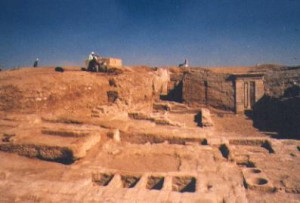
Risultati molto importanti si sono avuti nella campagna di scavo effettuata in novembre 1999, programmata per completare l’esplorazione del nuovo tempio (Tempio C). Nel 1999 la missione dell’Università di Pisa in congiunzione con l’Università di Messina, ha completamente esplorato il settore nord del Primo Cortile, dove, in parallelo con la struttura benissimo conservata rilevata durante le stagioni precedenti sul lato nord (Annesso I), è stata rilevata una struttura parallela, ma in stato di conservazione molto peggiore (Annesso II). Una stretta strada separa l’Annesso II dalla facciata del tempio, e permette di accedere al cortile che fronteggia l’ergasterion, individuato ma non esplorato la scorsa campagna 1998. Questo edificio con volta, e a un solo piano, ha l’interno diviso in due parti da un muro di blocchi di pietra intonacati, alto m.1,30, disposto obliquamente rispetto all’asse; nel settore est, una pavimentazione di blocchi di pietra rivestiti da un duro intonaco, presenta due gradini bassi e una vasca quadrata (profonda m.0,30), con un versatorio che sbocca nel settore ovest. In questo settore, il pavimento è di sabbia pulita; la porta e una piccola finestra sono state trovate bloccate accuratamente con mattoni crudi.
Cosa eccezionale, che ha portato a rivedere l’ipotesi di lavoro dello scorso anno, che proponeva di riconoscere nell’edificio con la volta a botte un ergasterion per la fabbricazione del vino del tempio, è stato trovato nel pavimento sabbioso una buca profonda circa m.0,60, piena di più di trenta uova di coccodrillo, ricoperte da uno strato di sabbia. Molte delle uova presentavano feti di coccodrilli a vari stati di evoluzione, alcuni arrivati a completezza. Questo ha portato a ipotizzare per l’edificio la funzione di nursery per coccodrilli sacri, che usciti dalle uova, potevano essere messi nella vasca , probabilmente per un breve periodo, prima che gli animali venissero sacrificati e mummificati, e venduti ai devoti di Sobek in visita al tempio e alla necropoli dei coccodrilli. La mancanza di paralleli archeologici di ritrovamento di uova di coccodrillo in un annesso a un tempio di Sobek rende difficile, almeno per ora, di emettere se non ipotesi. Ma l’ipotesi trova una conferma in un altro importante ritrovamento di questa stessa campagna; nella struttura speciale (Annessso III) riportata alla luce a nord del Primo Portale, in due delle sette cavità accuratamente aperte nel pavimento, sono state trovate altre uova di coccodrillo, per un totale di sessanta. Presso le cavità era stata sistemata una vasca di pietra, quadrata, profonda m.0,25-0,30; un’altra nursery, dunque, per neonati coccodrilli sacri. Fra i reparti della campagna 1999, ricordiamo alcuni importanti anche se frammentari papiri greci, ieratici e demotici. Sono state individuate, e solo parzialmente esplorate, due zone di necropoli, nell’immediata vicinanze della città, sul lato sud-ovest; la prima comprendeva fosse ricavate nella sabbia e rivestite di blocchi di calcare regolari (prob. epoca tolemaica), tutte trovate manomesse da ladri e prive di reperti; la seconda, più a sud, comprendenti sarcofagi grossolanamente antropoidi, in terracotta, molti manomessi, molti intatti, contenenti corpi divenuti scheletrici, bendati e coperti da uno strato sottile di gesso con pitture di vario colore; non è stato trocato nessun amuleto o altra suppellettile funebre.
Relazione del Prof. W. Landini, Università di Pisa
Membri della Missione: E.Bresciani, Direttore; Rosario Pintaudi, Papirologo; Flora Silvano, Egittologo; Antonio Giammarusti, Architetto; Helal di Moh.Mostafa di Sayed, Ispettore delle Antichità del Fayum.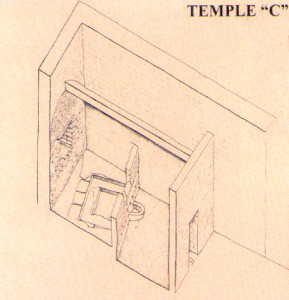
La parte posteriore del tempio C è stata completamente liberata dall’enorme massa di sabbia e detriti (il materiale trasportato può essere calcolato a mq. 640) e il muro posteriore del tempio mostra adesso il paramento intatto, con le finestre a feritoia. Dietro il tempio esisteva una larga zona senza costruzioni. L’indagine ha confermato che l’edificio coperto a volta – chiamato convenzionalmente “Nursery I” – contiguo al tempio C, è stato costruito contemporaneamente con il tempio stesso. L’area immediatamente a nord del tempio C non stata oggetto di scavo a causa della presenza di un casotto usato dai poliziotti delle Antichità; poiché l’esplorazione di questo settore non potrà essere differita oltre il prossimo anno, le Antichità egiziane dovranno provvedere allo spostamento del casotto stesso.
Sul lato sud del Tempio C, l’area utile a chiarire le strutture parallele al tempio si sviluppa per una lunghezza di oltre 30 m.; il kom sovrastante da asportare supera anche qui i 5 m. Il fronte occidentale, sgombrato quest’anno su una lunghezza circa 12 m., ha permesso di portare alla luce gli ambienti di un edificio molto importante, appartenente a una serie di case parallele al muro sud del Tempio C ( separate da esso da una strada larga circa 6m.), che sul lato ovest sono parallele al dromos delle sfingi del Tempio A.
Queste case, la cui esplorazione occuperà le prossime campagne, si trovano in una posizione panoramica rispetto al dromos, costruite come sono sulla collina; il crollo che ha coinvolto l’edificio scavato quest’anno e situato al livello del Tempio C e della piazza antistante, non ha impedito di rilevare interessanti particolari sull’edificio: la casa aveva almeno due piani (il soffitto del piano terra era fatto di travi e travicelli che sostenevano un canniccio di giunchi, intonacato; le stanze erano intonacate di bianco (l’intonaco del pianoterra è annerito per un utilizzo tardivo forse nel III-IV sec.); le stanze del piano superiore erano intonacate di bianco con decorazioni floreali colorate (sono stati raccolti molti frammenti degli intonaci). Costruite sul pendio della collina sovrastante il dromos, tutte le case di questo settore avevano cantine, che erano probabilmente in vista sul lato ovest, come in altri contesti urbani del Fayum d’epoca greco-romana e l’accesso alla porta d’ingresso era allora raggiungibile mediante scala esterna.
Ognuna delle due stanze scavate quest’anno aveva una cantina coperta a volta; nella cantina di A (due ambienti voltati) si scendeva mediante una botola, e l’accesso era facilitato dalla presenza di scalini a ventaglio (perfettamente conservati) coi gradini intonacati; la cantina di B (pure voltata) era accessibile mediante una porta aperta su un corridoio della tromba delle scale (sono conservati benissimo i gradini di legno) che davano l’accesso al primo piano e alla terrazza.
Una specie di sottoscala coperto a volta permetteva di passare, al livello cantina, dalla tromba delle scale alla cantina della casa adiacente est, esplorazione che fa parte del programma della prossima campagna di scavo.
La conoscenza di questa parte importante della città, che è l’area dei templi, sta ampliandosi e promette di fornire dati di primaria importanza per la storia urbanistica di Medinet Madi in epoca tolemaica. I ritrovamenti di papiri greci e demotici sono stati esigui, tuttavia non sono mancati pezzi interessanti; un ostrakon greco e uno demotico sono di singolare rilevanza epigrafica. Sono state ritrovate molte lucerne di terracotta di diversa epoca e di tipologia. L’abbondante ceramica dal tempio C e quella della campagna 2000 è stata studiata e disegnata; è stata individuata nella zona periferica sud est della città, la presenza di una fabbrica di ceramica, e, forse, di una di vetro. La localizzazione delle necropoli del Medio e Nuovo Regno, e quella degli animali sacri (cobra e coccodrilli) resta per ora una questione aperta.
Membri della Missione: E.Bresciani, Direttore; Rosario Pintaudi, Papirologo; Flora Silvano, Egittologo; Antonio Giammarusti, Architetto; Giovanna Bartoli, disegnatrice; Helal di Moh.Mostafa di Sayed, Ispettore delle Antichità del Fayum.
The Pisa University/Messina University expedition directed by Edda Bresciani and Rosario Pintaudi continued investigating the buildings on the hill south of the Temple C which are buried under an enormous mass of sand and rubble.The houses exposed were situated in a panoramic position above the dromos of the site’s main Temple. One imposing building containing many stone blocks, including the staircase to the upper floor, had the ceiling of the ground floor supported by large beams and the walls of the rooms plastered and painted in colours imitating marble, as well as panels of different stones; the collapsed walls of the upper floor were decorated with floral motifs.
The main hall had 2 stone pillars and a special place adapted to receive a large stone ara (altar?) A vaulted cellar, accessible through a trap-door, contained many well preserved wooden objects of daily use, including a miniature doll¹s chair.
The excavations also provided many Greek papyri, some Greek ostraka, glass, ceramics, and lamps dating from 1st-2nd century AD. Consolidation and restoration of the mud-brick structures in Temple C and in the new discovered buildings took place, and the sand was cleared from the staircases of the Temple A. A new program of geophisical exploration of the site was also launched by the Trieste Univ Institute for Applicated Geology, led by Michele Pipan amd accompagnied by Marco De Vecchi.
Membri della Missione: E.Bresciani, Direttore; Rosario Pintaudi, Papirologo; Flora Silvano, Egittologo; Antonio Giammarusti, Architetto;Giovanna Bartoli, disegnatrice; Helal di Moh.Mostafa di Sayed, Ispettore delle Antichità del Fayum.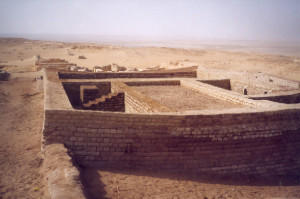
The Pisa University and Messina University expedition directed by Edda Bresciani and Rosario Pintaudi (members: A. Giammarusti, F. Silvano, A. Menchetti) extended the investigation of the buildings southward of the pillared house discovered last season.
The excavations provided greek papyri and ostraka (I-II century AD), rich series of roman glass (studied by Flora Silvano), ceramics, copper house furniture, coroplastic and fayence items; the pottery from this and the previous season has been studied for the publication.
The Trieste University Institute for Applicated Geology, led by Michele Pipan, continued the program of geophisical exploration of the site.
The Middle Kingdom Temple (Temple A) of Medinet Madi has been monitoreted for consolidation: the definitive architectonic recording of this very important monument has been completed (arch. Antonio Giammarusti) for the imminent publication (“Projects”, ed. Edda Bresciani, Pisa 2003).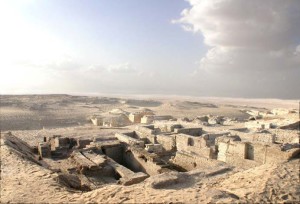
Mission 2003
Between October and December 2003, the Pisa University, working with the collaboration of the Messina University[1]continued the exploration of the Medinet Madi area, extending the investigation of the very important buildingssouthward of the buildings discovered last season; the excavations provided many greek papyri and ostraka (I-II century AD), rich series of roman glass (under study by Flora Silvano)[2], ceramics, important pieces of coroplastic and fayence items. A complete wood door of good work has been discovered in room M; a square piece of palm fibre, in very well conditions, was maybe used as protection in a window.
The buildings discovered during the exploration, are located at two different level; the great house (MM003/I) whose walls in West front have been found in bad conditions, has two rooms with stone staircase, and it is characterized by a large niche in room G1, where is a vaulted cantina (found empty). At the ground level, has been found a very beautiful head of a pottery man statue.
A door open in a very thick wall, conducts to a court F, with a well builted oven for bread. The two houses (MM003/II and MM003/III) builted on an upper level, separated by a narrow street, have doors in stone lintel and enjambments; MM003/II seems consist in only a room (O), large and with large niches and a court (?) (P), open at Nord to a street.
MM003/III has an imposing stone staircase, and a store under the staircase, rich in wood coating; the house presents in both his two rooms niches with wood shelves (partially conserved), maybe indication for an official destination of the building. The principal door open in N, is bringing to a street, which will be cleaned during next season.
The pottery from the present and the previous seasons has been studied for the publication by Giovanna Bartoli [3]. A group of coins found during the 2001 season, has been committed for publication to an expert of numismatic of Messina University [4].
The Mission that is carrying out a program of interventions at Khelua and control at Kom Madi sites continued the consolidation and restoration of the important building at Narmuthis, found during the 2002 expedition; a work of restoration is made on the discovered structures.
During the season has been confirmed the important project of take away the high sands that are covering areas of temple A, of Temple B, courts, stoà and dromos with his kiosque.
At Medinet Madi the Trieste University Institute for Applicated Geology, led by Michele Pipan, continued the program of geophysical exploration of the site, using innovative geophysical methods and not-invasive techniques.
For the urbanistic history of Fayum in Greco-roman period we must mention in this preliminary Rapport the large hall with two stone pillars and the walls covered bay plaster decorated with geometrical motifs; the coloured plaster in good part conserved and the hall has been protected with a complete wood roof covering upon the walls integrated. The hall – probably a hall for session of a association- is connected with the one-room house discovered in season 2003.
Mission 2004
At Medinet Madi the new excavations have confirmed the interest of the site; here the groups of buildings are separated by streets, perpendicularly to the dromos and to the large street – running along the South side of Temple C- cleared during the season. The North insula of buildings has suffered by later installations and dwellings, but a great vaulted cellar is in perfect conditions.
On the coloured plaster, many late (childish?) drawings, representing boats of different types; a vary interesting drawn is on the plaster in South wall, near the South pillar, and represents a bust of abreast pharaoh; the ureus on his head and the eyes are very clear. It could be a image of Amenemhat III-Premarres [5], and the hall could be for the reunion of a Premarres’s cultural association.
[1]: Members of the Mission (2003): E. Bresciani; R. Pintaudi; F. Silvano; G. Bartoli; M. Pipan; A. Menchetti; A. Forte; R. Buongarzone.
[2]: F. Silvano, Vetri bizantini dall’Egitto. Medinet Madi 1988. Catalogo delle Collezioni Egittologiche, Pisa 1999; F. Silvano, «Vetri romani dai recenti scavi a Medinet Madi (Egitto)», Vetri di ogni tempo, vol. I, 13, Massa Martana, 2001; F. Silvano, «Glass Finds from Medinet Madi, Egypt», Annales du 16e Congrés of the Association Internationale pour l’Histoire du Verre, London 2003, in press.
[3]: G. Bartoli, La ceramica del tempio C di Medinet Madi, ETS, Pisa, 2005, in press.
[4]: Castrizio, «Le monete da Medinet Madi, missione 2001», EVO XXVII, 2004, pp. 17-26.
[5]: E. Bresciani, «Il culto di Premarres nel Fayum», EVO IX, pp. 49-58.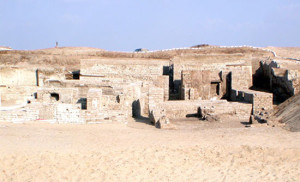
In the year 2005, the Pisa University (working with the collaboration of Messina) developed a program in two parts, the first in October, the second in November 2005.
The program of October was asking to prepare a “CATALOGUE” of fragmentary findings of previous expeditions (2000-2004), items (parts of woods, pottery, ropes etc.) which the SCA inspectors, accompanying the Italian mission during the different seasons, don’t register, but of scientifical interest for the mission, kept, in a chronological order in cartoons, in the closed Mission Stores at Medinet Madi. Our program foresees that, after the study during this mission, the fragmentary and week objects could be transferred to the SCA Kom Ushim Magazine according with the new law.
During the November month, we decided to continued the exploration of Medinet Madi area, extending the investigation of the buildings southward of the buildings discovered last season, at South-East of the painted hall. TheMission continued the consolidation and restoration of the building found during the 2004 expedition.
The cleaned area of 2005 is large, but the buildings have been found in very bad condition (because the earth quark of the year 307 ?), in part also ruined by fire; the excavations provided few objects, few little fragments of Greek papyri, some late and fragmentary pottery and fayence items.
The items registered, according to the choose of the SCA Inspectors, and all the fragmentary material found during the excavation, have been transferred in box to Kom Ushim Magazine according with the new law about excavations.
The SCA Inspector accompanying the Pisa University Mission in October and November 2005 was Mr Ouni Mokhtar Hassan el Hossary.
The Castrum Narmoutheos recognised
The Mission of the University of Pisa has effected in the period October-November 2006 the usual annual activity in the Fayum.
The first part has been devoted to the continuation of the work of consolidation and restoration to the rock-cut Tomb of the Prince Uaget to Khelua under the superintendence of the architect head of the SCA to the Fayum Mr.Abd el Alym Mynisier, that has collaborated with competence and share.
The 12 pillars of the hypostyle have been completed in height; the state of maintenance of the sculptures of the pillars has been monitored; the door of principal access has been closed with a door in iron; a secondary door has been blocked; the inferior part of the 6 fragmentary statues in external façade has been in a large extent restored and protected, eliminating the incrustations of salt that had altered her. Such work has been conducted directly by the personnel of the department of the restoration of the Inspectorate of the Fayum. The closing of the ceiling and the definitive completion of the restoration will be object of the next mission in 2007.
The second part of the season, as foreseen, has been conducted in Medinet Madi, in the area chosen by the Mission and approved by the SCA according to the undersigned contract.
During the operations of excavation have been brought to the light the principal structures of the Roman military camp, whose construction goes up at the end of the III century AD under the kingdom of Diocletian. About the existence of such camp we were informed till now only by manuscript sources (Notitia Dignitatum) and from some Greek papyrus. The Castrum of Narmuthis-Medinet Madi was the second Roman military camp of the Fayum, over that well known of Kasr Qarun, but till now it had not been located and discovered.
It is a quadrangular structure with walls of great thickness, strengthened with 4 angular towers and a circular central tower; endowed with two entries, the principal on the north side, the secondary one on the south side.
Has been shown great part of the perimeter and about halves the lodgings of the soldiers, destined to entertain the Cohors IV Numidarum located in Narmuthis under the command of a Roman tribunus.
The recovery of objects is limited to few bronze coins of the IV century AD, to modest and fragmentary rests of ceramics of daily use and to a fragment of relief on limestone with rest of colours, that represents the goddess Isis-Renenut in its usual form of feminine body and the inferior part of the body of cobra, but having a large squamous snake in relief on the chest.
The material written, all in Greek, is constituted by an ostrakon that it brings names of person and from some fragments of wine’s containers that they preserve the name of the owner, certainly a soldier.
The state of maintenance of the fortress has imposed us a big work of restoration and consolidation of the structures of mud bricks, mainly the enormous foundations, that it will continue together with the work of excavation in the next mission 2007.
In the second halves the month of November, according with our application to the SCA, a work of consolidation and restoration has been initiated in one of the houses of the second court of the temple of Medinet Madi. Such work has been conducted in accord with the Department of architecture and restoration of the Inspectorate of the Fayum and bottom an inspector’s control sent by the SCA.
The mission was accompanied to Khelua and Medinet Madi by the inspector of the SCA Mazhar Ezt El Rweesy and by the inspector of the SCA Rezk Diab Ghadiry Hassan.
Members of the Mission:
Edda Bresciani-Director, Rosario Pintaudi-Messina University,
Antonio Giammarusti architect, Flora Silvano, Angiolo Menchetti.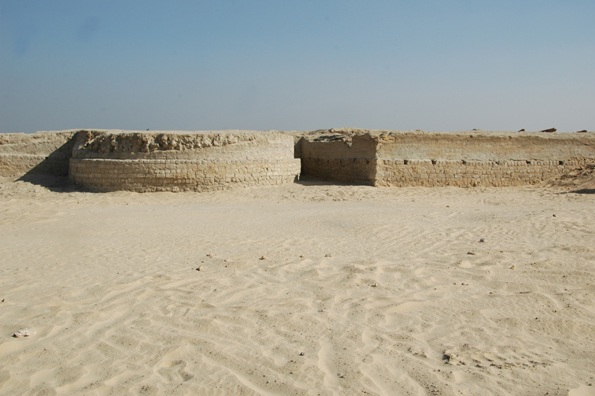
Preliminary report, April 2007
The archaeological Mission of the Pisa University has effected a mission during the month of April 2007, at Medinet Madi in Fayum, in continuation with that of October-November 2006, when happened the important discovery of the location and exploration of a Roman fortress, the Dioclezianus’s castrum Narmoutheos, localized in the archaeological concession of the Pisa University thanks to the use of a satellite map with the archaeological controls.
Till this discovery, the two sources for the existence of a castrum at Narmouthis in late roman epoch were the paragraph XXVIII, 46 of the Notitia Dignitatum (known historical source compiled at the end of the IV century), and a Greek papyrus of Theadelphia (P.Thead.4) that preserved the name of the commander of the castrum, Flavius Salvitius, in 328 AD.
After this, in November 2001, the Pisa archaeological mission during the exploration of a house to south of the temple C, found, written on a Greek contract of guarantee dated to 326 A.D., the name of the same commander, now with the title of tribunus.
The only castrum of the Fayum till now recognized on archaeological site, excavated and published (at the end of the years ’40) was that of Kasr Qarun, the ancient Dionysias, with two temples and the great fortress; the castrum Dionysiados- so named it in the Notitia Dignitatum- is well known thanks to the splendid Greek archives of Flavius Abinneus, commander of the Ala Quinta Praelectorum, troops of cavalry quartered in the castrum of Kasr Qarun.
As announced in the Report 2006, the castrum Narmoutheos, that entertained the Cohors Quarta Numidarum, has a quadrangular structure (50 x 50 ms.) with walls of mud bricks, thick 3,80 ms., strengthened with 4 angular towers and a circular central tower on the west side, placed side by side with another thick rectangular tower; it is endowed with two entries, the principal on the North side, built with prevalence of mud bricks and stone, the second one on the South side, toward the city, built in fired red bricks tied by mortar. On the East side, the wall and the bastions are practically to rock level, but are been traced in the plan.
Inside the fortress the exploration has been continued in April 2007 in the lodgings of the soldiers; the rooms in the zone South-West gave ceramic material of fragmentary kegs of ellipsoidal form ( have been counted the necks of some hundred kegs) presumably destined to contain the daily ration of wine (measured capacity l.0,75, a tenth of the capacity of the roman amphorae for wine in Fayum); on the most greater part of the fragments have been found written Greek names, often accompanied by the patronymic, surely the indication of ownership.
The exploration of the inside lodgings of the fortress is continued, in the West-North area, where the modern destruction has been less deep than of the oriental South half of the camp, allowing a survey of environments with preserved walls around the meter; it seems to be able to recognize a private lodging, maybe for the use of the chief of the castrum; this principal room preserves part of the original plaster and we found many fragments of the decoration with geometric motives. This sector of the castrum didn’t directly access the zone of the cistern; but we found a singular installation still in situ, a plumbing of tuboli in tile along the walls of a elbow corridor, but we not have been able to recognize from where was destined to take and to bring where the water; perhaps a projected plan but not finished.
A long wall, currently tall less than a meter but that, calculating the height of the level on base the adjacent vault of the cistern, had to present himself with a height of around m. 1,70; using the comparison with Kasr Qarun, we can propose that on the raised base orbema; on the axle of the door North, existed the “chapel of the insignias”, flanked by two rooms.
The most important discovery of this mission is certainly that of a complex hydraulic system and till now without parallel, certainly worthy example of the hydraulic engineering of the Romans.
It is a square cistern (side: m. 3,35) inside the castrum, immediately after the entrance South, cut in the rock, and entirely covered by a vault in fired bricks. The vault has been found not whole, probably broken down by the fall of a great capital Corinthian for pillar (found collapsed inside the cistern).
The capital presumably originates from the colonnade that departed from the door North (on the
model of Kasr Qarun) or maybe from the architectural structure of the chapel, as also two bases and columns found under the level between sand and collapses of wall in the room KMM South 3.
The destruction and the spoil of the castrum was performed, can be hypothesized, in the epoch of the to bloom of churches in Medinet Madi, and has been completed by the devastations of the sebbakhins.
The findings of objects in April 2007 consist in ceramics, some Greek Ostraka, few bronze coins very oxidize, and in a bronze bracelet, of Christian epoch adorned with a monogram of Christ.
Also during the mission of April 2007 has been devoted great care, time and money for the protection and the maintenance particularly of the hydraulic installations.
The mission, formed by E.Bresciani, R. Pintaudi- Messina University, Angiolo Menchetti, the architect Antonio Giammarusti, was accompanied by the Inspector of the SCA Mohammed Badr el Din Hassan, who has been of great help and good collaboration.
Prof. Edda Bresciani Director of the Mission
Medinet Madi October 2006-April 2007

Preliminary Report, November 2007
The archaeological Mission of the Pisa University – with Prof. Rosary Pintaudi, Messina University
has effected a mission during the month of November 2007, in the archaeological concession of the Pisa University at Medinet Madi in Fayum, in continuation with that of April 2007.
Inside the fortress has been continued the exploration in the lodgings of the soldiers, in the South half of the camp and the West-North area. The long wall, is confirmed as the raised base or bema; on the axle of the door North, existed the “Chapel” for the imperial cult, flanked by two rooms; the colonnade that departed from the door North (on the model of Kasr Qarun) arrived near the long wall, and the raised zone of bema was reached by 4-5 steps.
Outside of the castrum, in the north zone, has been discovered a “forno”, maybe industrial maybe for alimentary aims.
Prof. Edda Bresciani Director of the Mission
Medinet Madi 26 November 2007
The hydraulic system of the Castrum and the village
In April 2007 had been discovered inside the castrum a complex hydraulic system and till now without parallel, certainly worthy example of the hydraulic engineering of the Romans, a square cistern (side: m. 3,35) inside the castrum cut in the rock, and entirely covered by a vault in fired bricks.
But it was necessary continue the control of the system of the adduction and derivation channels; during November 2007 expedition this has been obtained with trenches till the actual fields, under which the old channel continues.The old agricultural channel, oriented South-North, gave water to the castrum’s cistern with a system of two tubs related by channel; an other water point present eleven steps to reach the cut- rock channel.
The place of two old saqyia is to recognize in the South section of the channel. This section of research (to be continue during next seasons) has been studied – for publication- in the exploration November 2007 by Emenuele Brienza.
It is clear that the explorations of this year show how it is necessary the control of the still existing areas around the archaeological sites, to avoid that the new cultivations could destroy the rests of ancient civilisation. We could call this interventions of our archaeological missions with the definition of “urgency excavations”.Also during the mission of November 2007 has been devoted great care, time and money for the protection and the maintenance of the big walls of the castrum and of the inner installations and the channel line with the important water points.
The Pisa University mission, formed by E.Bresciani, R. Pintaudi, Flora Silvano, Angiolo Menchetti, Antonio Giammarusti architect and the archaeologist and topographer Emanuele Brienza- Rome University, was accompanied by the Inspector of the SCA Mohammed Hamed Mohammed Ahmed, who has been of great help and good collaboration.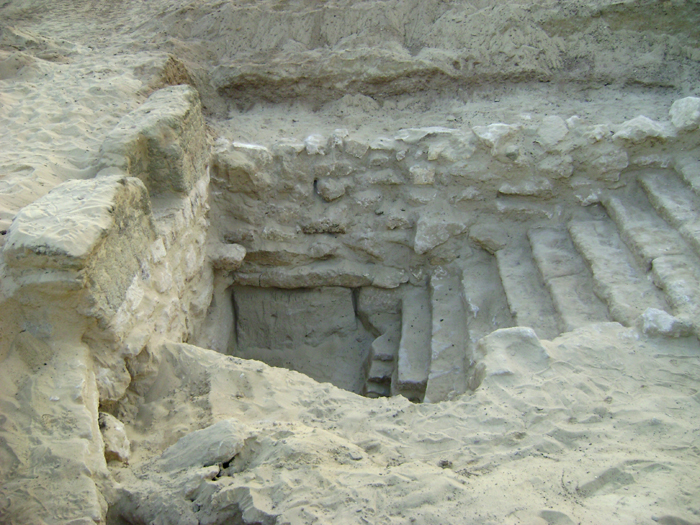
Wadi El Rayan rassegna stampa da “IL GIORNALE DELL’ATENEO“
Conference October 14th, 2010
Madinet Madi
The Past, the Present and the Future: Shading more Light on the Scientific Work in the Archaeological Site of Madinet Madi
The ISSEMM Project,Institutional Support to Supreme Council of Antiquities for Environmental Monitoring and Management of the Cultural Heritage Sites: applications to Fayoum Oases and North Saqqara Necropolis, had his official start up in 2005 with training course and general organization; the on sites activities started in January 2009.
This project is acting withinn the framework of the Egyptian-Italian Environmental Cooperation Program Phase II, which is one of the international channels through which the Government of Egypt implements policies and actions to support and enhance cultural and environmental national heritage.
The Project is entirely funded by the Italian Ministry of Foreign Affairs-Directorate General for the Development Cooperation, which grant has been up to 3.500.000 euro.
The ISSEMM Project is directed by His Excellency, Secretary General of the Supreme Council of Antiquities, Dr. Zahi Hawass, whereas the Scientific Committee is chaired by Prof. Edda Bresciani, Accademica dei Lincei, and Prof. Ali Radwan. The Scientific Committee is supported by a Technical Direction composed by an Egyptian – Italian team of Technical Managers. The University of Pisa, Dipartimento di Scienze Storiche del Mondo Antico, has been appointed with the task of technical and scientific assistance to the Supreme Council of Antiquities, which is the Implementing Agency of the project. UNDP support the program under administrative view point
The ISSEMM project aims to improve the management of archaeological sites in Egypt and its efforts have been applied on the case studies of North Saqqara Necropolis and Fayum Oasis.
Activities in North Saqqara
The project has implemented the monitoring system started during the years 2000-2002 in the framework of the “Enhancement of the Organisation and Capabilities to Preserve the Cultural Heritage of Egypt – Risk Map for North Saqqara site”, also known as Risk Map of North Saqqara (RMNS), that has given the origin to the current project of Phase II. In the present phase, 15 tombs have been included in the environmental monitoring system. The system monitorizes the variations of the essential parameters related to the wall paintings conservation, which are: temperature, relative humidity, CO2 . It is an instrument that will allow the Site Direction to manage the site respecting flexibility and safety requirements. The activities included the technical support to SCA personnel, through training courses, that have been carried out in 2005-2006.
Activities in Fayum
The Project has aimed to experience through this pilot project to create the first archaeological park, connected to a protected area, whereas both sites deserve appropriate conservation and enhancement methodologies and approaches. To physically connect Madinet Madi archaeological site to Wadi El Rayan Protected Area a 27 km long unpaved track has been realized. The route of such track respects the landscape and it enhances its panoramic characteristics.
Thanks to the Institutional Dialogue Process activated among the involved institutions: Italian Cooperation, UNDP Egypt, EEAA, Fayum Governorate and SCA it has been possible to fulfill this important goal.
The project investigated the environmental and cultural assets in Fayum Governorate through the analysis on a territorial scale elaborated through a Geographical Information System. The task of this geo-database is the reproduction of the general framework of the oasis by thematic layers that is the base for the elaboration of instruments such masterplans drawn up to enhance local resources and foster sustainable development. The G.I.S includes touristic routes in Fayum, linking natural areas and archaeological sites, in particular the new desert track realized by the ISSEMM Project.
The activities in Madinet Madi archaeological site have been aimed to the opening of the site to the public and have consisted in sand removal, archaeological survey, monuments consolidation and restoration, visiting path, and as well as the Visitor Centre and eco lodge realization.
The numbers of Madinet Madi Archaeological Site:
The sand removal activity has been carried out on a surface of 420 m of length and 20 m of width, through an average depth of 4 m. The total volume of removed sand has been of 35.000 cm.
1.000.000 mud bricks have been used, in order to consolidate and restore mud brick monuments.
More than 180 workers, from the local communities, have been employed for the sand removal activity, whereas 90 restorers, specialized personnel of Supreme Council of Antiquities, worked one year, within the ISSEMM Project to create the Madinet Madi Archaeological Park.
The monuments of the archaeiiological Park
The ruins of Medinet Madi contain a considerable amount of monuments and the only worship temple of the Middle Kingdom – with texts and engraved scenes – still remaining in Egypt, discovered by the Milanese Achille Vogliano (1935 – 1939). The history of Medinet Madi starts in the Middle Kingdom (beginning of the II millennium BC) with the foundation (within an agricultural project in the Fayoum region) of a village called Dja, and the construction of a temple by Amenemaht III and Amenemaht IV dedicated to the cobra goddess Renenutet and the crocodile god “Sobek of Scedet” – patron of the entire region and its capital Scedet –”Horus who resides in Scedet”. During the Ptolemaic period, Dja – now called Narmouthis, a Greek name meaning “the city of Renenutet-Hermouthis” – and its temple flourished, and more monuments were built North and South of the 12th dynasty’s temple. Achille Vogliano’s discovery of the Amenemhats’ temple (Temple A) and of the Greek-Roman additions
Starting from the IV-V century,Medinet Madi-Narmouthis saw intense Coptic settlement with the construction of churches; the Arabs called it Medinet Madi “the city of the past”, and this is the name that still today identifies this archaeological area.
The exploration in Medinet Madi has been carried out by the University of Pisa since 1978,in Kom Mai, after in Medinet Madi where on the southern or Coptic area has identified ten churches (V-VI century) important in the history of Fayoum’s ecclesiastical architecture.
The researches of the archaeological campaigns between 1997 and 2004 (in collaboration with the Universityof Messina – Chair of Papyrology) brought to light a new ptolemaic temple (Temple C) dedicated to the worship of two crocodiles; in a structure joined to the temple, an integral, barrel-vaulted structure for the incubation of crocodiles’ eggs.
Thanks to the contribution from the Italian Ministry of Foreign Affairs, Italy-Egypt 2004, the Pisa University mission has also seen to the rescue of the blocks with the four Greek hymns to Isis, their restoration and placement in the Museum of Karanis.
A methodical topographical survey, a photo-interpretation of the site and geophysical exploration have contributed, in recent years, to an understanding of the urban tissue of the ancient village, in its chronological stratification, until the Late Byzantine Age .
In 2007 a very important discovery was made: the powerful castrum Narmutheos, of Diocletian period .
In 2008 the second phase of the Italian-Egyptian cooperation programme started, the ISSEMM project. The archaeological results of the sand removal of the sacred area are very important, the whole dromos South-North is now of 230 m., from the original access with sacrifices alatar, four statues of lions and one of lioness (inique, without parallels), new dedicace greek inscriptions datated to the year 116 B.C.
The whole new facies of Medinet Madi-Narmouthis is someting inique in the frame till now known of the architecture of temples not only in Fayum but we can say in all Egypt.
Project Staff:
Dr. Zahi Hawass SCA Secretary General
Prof. Edda Bresciani Scientific Director
Prof. Ali Radwan Scientific Director
Arch. Antonio Giammarusti Technical Director, Co-Mager
Mr. Hisham El Leithy Technical Director, Co-Mager
Prof. Feisal Esmael National Co-Manager
Arch. Angela De Vita International Co-Manager
Arch. Mahmoud Farouk Mohamadain Technical co-manager assistant
Arch. Francesca Veronica Rubattu Landscaping designer
Mr. Ahmed Abd El Aal Hassan General Manager of Fayoum Inspectorate
Dr. Roberto Buongarzone Egyptologist
Machmoud Ibrahim Egyptologist
Mr. Said M. Mostafa SCA Inspector
Mr. Sayed A. M. Shouip SCA Inspector
Dr. Emanuele Brienza archeomatic expert and topographer
Mr. Giovanni Caratelli Surveyor
Mrs. Cinzia Filippone Surveyor and muselogist
Mr. Mohie Abd Alhamed Topographer
Mr. Saber Atia Dwib SCA Inspector
Mr. Gamal Abdel Maguid Mahgoub Architect Restorer
Mr. Waad Allah M. Abu el Ella Architect Restorer
Mr. Elsayed A. M. El Shahat Supervisor of Restoration
Mr. Mohamed S. M. Salem General Director of Restoration
Mr. Abdelaleem M. A. Megeed chief Engineer of Fayoum Inspectorate
Mr. Hussain A. M. El Kader Restorer
Mr. Amgad A. Elsalam Restorer
Mr.Zidan A. Abdel Samei Restorer
Mr. Elsayed S. R. Ahmed Restorer
Mr. Gamal E. A. Elsalam Restorer
Mr. Raouf Hasanien Hamed Restorer
Mr. Rabeea M. Y. Abd El Fattah Restorer
Dr. Massimo Testardi UniPisa Administrative Officer
Mr. Mohamed Yousef Administrative Officer
Mr. Karim El Zoghbi Accoutant
